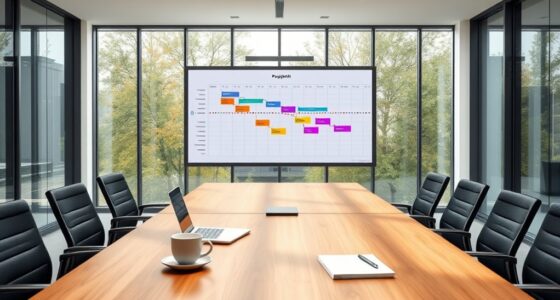When facilitating retrospectives, choose formats like Start-Stop-Continue or the 4Ls to encourage open, structured feedback, fostering team growth. Use techniques such as timelines or fishbone diagrams to visualize progress and identify root causes of issues. Incorporate interactive tools like digital platforms to boost participation and track improvements. Creating a safe, inclusive environment helps team members share honestly, making retrospectives more impactful. Keep exploring to discover practical tips that will elevate your retrospective sessions further.
Key Takeaways
- Different retrospective formats like Start-Stop-Continue and 4Ls help teams reflect, uncover issues, and promote actionable improvements.
- Selecting the right format depends on team goals, dynamics, and the specific issues to address.
- Effective facilitation creates a safe environment, encourages honest feedback, and manages conflicts to maximize participation.
- Incorporating visual tools and interactive activities enhances engagement and helps surface deeper insights.
- Using digital platforms like Teams or Slack streamlines communication, tracks progress, and fosters ongoing team reflection.
Common Retrospective Formats and Their Benefits

Different retrospective formats can help teams uncover insights and improve their processes effectively. When selecting a format, you’ll face retrospective challenges like encouraging honest feedback or maintaining engagement. Strong facilitation skills are essential to navigate these issues and keep the team focused. For example, the Start-Stop-Continue method encourages clear, actionable discussions, while the 4Ls (Liked, Learned, Lacked, Longed For) helps surface deeper insights. Each format offers unique benefits, such as fostering openness or structured reflection. By understanding these options, you can choose the most suitable approach for your team’s needs. Effective facilitation guarantees that everyone’s voice is heard and that the retrospective remains productive, ultimately helping your team learn and grow. Additionally, incorporating essential oils with calming or clarifying properties can create a relaxed environment conducive to open communication and focus. Utilizing various retrospective formats can also help maintain team engagement and prevent fatigue during continuous improvement efforts. Recognizing the importance of facilitation skills ensures that the chosen format achieves its intended outcomes and keeps the team aligned. Moreover, understanding the best practices for facilitation can significantly enhance the effectiveness of your retrospectives. Being aware of business hours for team members or locations can also be beneficial when scheduling retrospective meetings to maximize participation.
Choosing the Right Retrospective Technique for Your Team
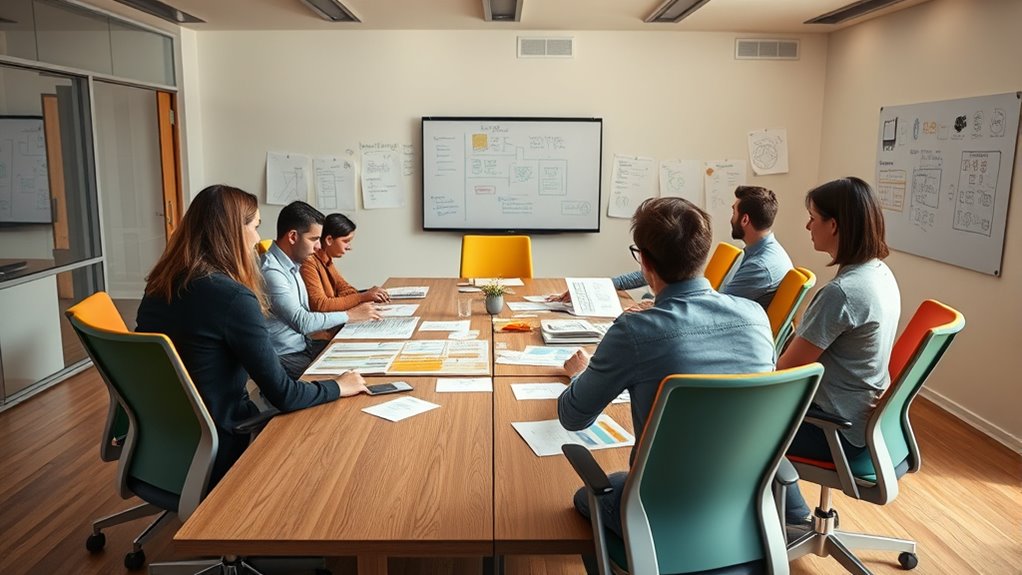
Selecting the right retrospective technique depends on your team’s goals, dynamics, and the issues you want to address. For teams with strong collaborations, techniques like dot voting can quickly identify key areas. If your team has diverse perspectives, methods such as silent brainstorming encourage equal participation. Consider your retrospective frequency; frequent sessions might benefit from quick check-ins, while longer intervals allow for deeper analysis. Use this table to choose wisely:
| Team Dynamics | Retrospective Frequency | Recommended Technique |
|---|---|---|
| Collaborative | Weekly | Appreciative Inquiry |
| Diverse Perspectives | Monthly | Brainwriting |
| Struggling to Engage | Quarterly | Start-Stop-Continue |
Matching techniques to your team’s needs boosts engagement and results. Additionally, understanding potential pitfalls in adopting new payment technologies can help you tailor your retrospective discussions to address relevant challenges more effectively. Recognizing the importance of team reflection can also enhance the effectiveness of your retrospectives by fostering continuous improvement. Furthermore, exploring facilitation strategies can ensure your retrospectives remain productive and focused. Incorporating best practices for remote facilitation can help maintain engagement in virtual settings. Being aware of techniques to handle conflicts during retrospectives can also improve your team’s openness and honesty during discussions.
The Start-Stop-Continue Method and How to Use It
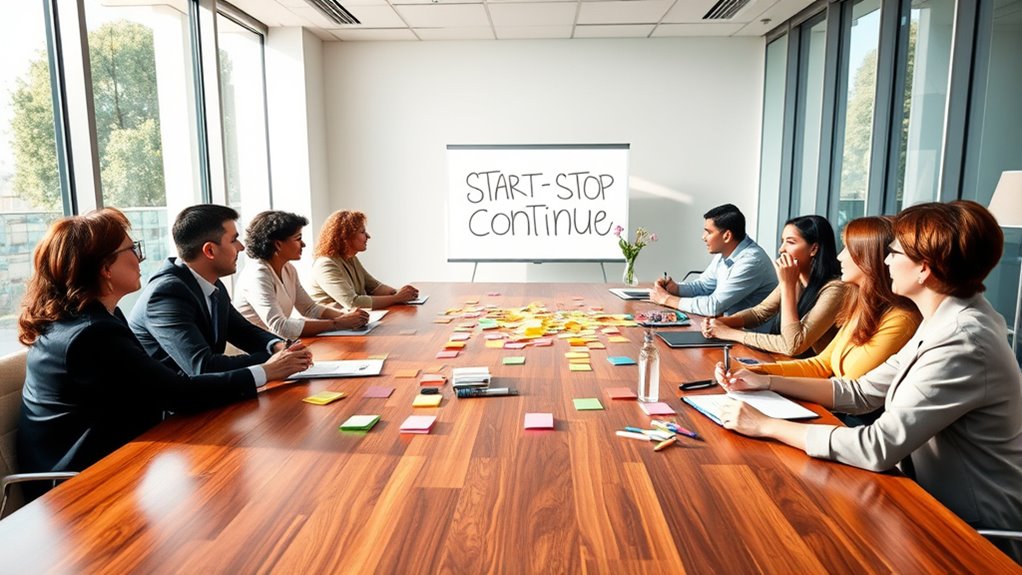
The Start-Stop-Continue method offers a straightforward way for teams to identify practices that are working well, those that need to be stopped, and new ideas to try. It encourages team member engagement by prompting everyone to share honest feedback on current processes. To maximize its effectiveness, keep the retrospective frequency consistent, such as monthly or quarterly, so team members stay engaged and can track progress over time. During the session, ask participants to list activities or habits to start doing, stop doing, and continue doing. This simple structure helps clarify priorities and fosters open communication. By regularly applying this method, you can create a continuous improvement cycle that keeps your team aligned and motivated. Incorporating tools like trustworthiness assessments can further enhance the process by ensuring the team’s confidence in the feedback provided. Additionally, understanding mental wellbeing factors can help tailor improvement strategies to support overall team health. Regularly reviewing feedback quality can also prevent misunderstandings and promote constructive discussions. Moreover, maintaining awareness of psychological safety promotes honest communication and open sharing within the team. Recognizing product shelf life and the importance of proper storage can serve as a reminder that consistent evaluation and adaptation are key to sustained success.
Using Timelines to Visualize Team Progress and Challenges
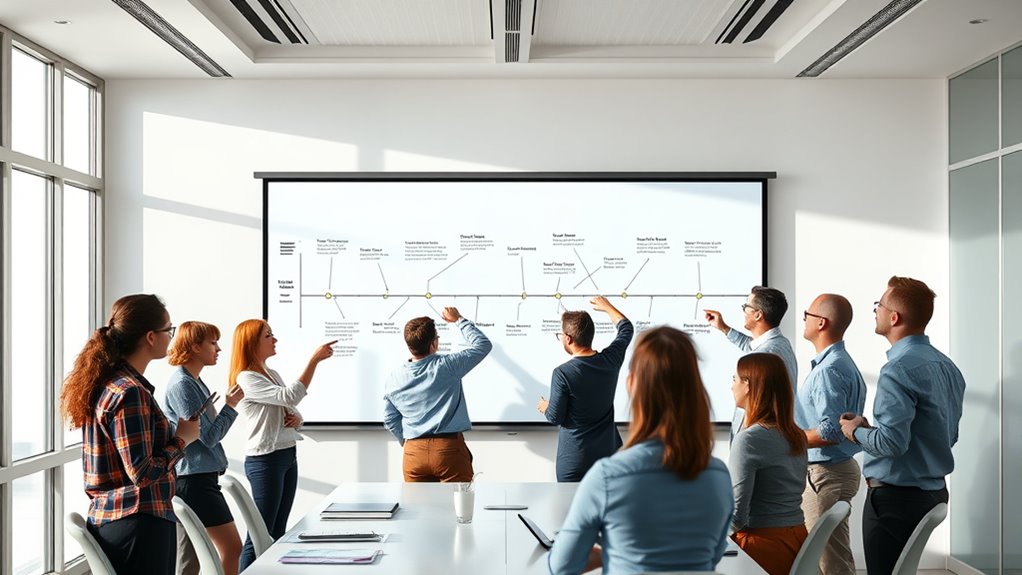
Using timelines helps you see your team’s progress clearly by charting key milestones. They also reveal bottlenecks that slow down workflows, so you can address issues more effectively. Tracking project metrics allows for better assessment of progress and areas needing improvement. By visualizing these points, you gain better insights into your team’s challenges and successes. Incorporating elements like short-form videos from platforms such as TikTok can also inspire innovative ways to present project updates creatively.
Charting Team Milestones
Timelines offer a clear and impactful way to visualize your team’s progress by highlighting key milestones and obstacles along the way. By charting team milestones, you create a visual record of significant accomplishments, making it easier to track progress and celebrate success. This milestone visualization helps everyone see how each contribution fits into the bigger picture, fostering a sense of achievement and momentum. This approach not only clarifies what has been achieved but also identifies patterns and areas for improvement. Using timelines to chart milestones keeps your team aligned, motivated, and focused on continuous progress. Incorporating tools like timelines can also help in tracking ongoing efforts and ensuring your security devices like Ring cameras are maintained and functioning optimally. Additionally, visualizing milestones can reveal trends in team performance and highlight opportunities for process optimization, leading to more efficient workflows.
Identifying Bottlenecks
By visually mapping your team’s progress with timelines, you can quickly spot bottlenecks that hinder workflow. These delays often impact team morale, leading to frustration and decreased motivation. Timelines reveal where tasks pile up or slow down, highlighting process inefficiencies. When a specific phase takes longer than expected, it signals a need to investigate underlying causes, such as resource constraints or unclear responsibilities. Addressing these bottlenecks improves overall process efficiency and boosts team morale, as members see their efforts translating into smoother progress. Regularly analyzing timeline data helps you pinpoint recurring issues and implement targeted solutions. This proactive approach keeps your team aligned, motivated, and focused on continuous improvement, ensuring project flow remains steady and productive. Identifying signs of spoilage in related materials can help prevent delays caused by defective inputs or misinformation. Additionally, monitoring resource allocation can help optimize workload distribution and prevent future bottlenecks. Recognizing the impact of automation in streamlining processes can further reduce delays and improve task completion times.
Fishbone Diagrams for Root Cause Analysis

A Fishbone Diagram, also known as an Ishikawa diagram or cause-and-effect diagram, is a powerful tool for identifying the root causes of a problem. It visually maps out potential factors contributing to an issue, making complex problems easier to analyze. When engaging in root cause analysis, you can use fishbone diagrams to systematically explore categories such as people, processes, and tools. Here’s how it works:
- Identify the problem and write it at the head of the diagram.
- Draw main branches for major categories affecting the problem.
- Add smaller branches to specify possible causes within each category.
Dot Voting and Prioritization Techniques
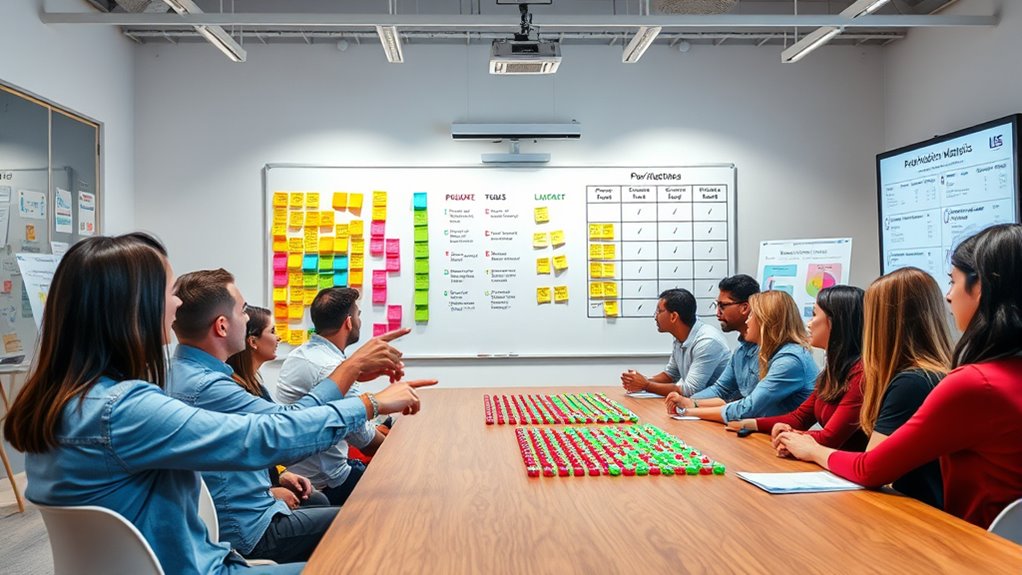
You can improve decision-making during retrospectives by applying effective voting strategies like dot voting. Understanding what factors influence prioritization helps guarantee your team focuses on the most impactful issues. By choosing the right techniques, you streamline discussions and reach clearer consensus faster.
Effective Voting Strategies
Effective voting strategies are essential tools for guiding team priorities during retrospectives. They leverage voting psychology to guarantee fair, unbiased decisions. When implementing these strategies, consider:
- Encouraging anonymous feedback to reduce peer influence and promote honest input.
- Using clear, simple voting methods like dot voting to facilitate quick consensus.
- Recognizing that voting behavior can be influenced by group dynamics, so set expectations to maintain objectivity.
Prioritization Decision Factors
Prioritization decision factors play a crucial role in guaranteeing team efforts focus on the most impactful issues during retrospectives. You need to contemplate stakeholder influence, as different team members may prioritize issues based on their roles or interests. Recognizing resource constraints is equally important, as limited time, personnel, or tools can shape which items are feasible to address first. Techniques like dot voting help surface collective preferences, but you should also evaluate how stakeholder influence might sway results. Balancing these factors ensures that your team targets problems with the highest impact and practicality. By consciously weighing stakeholder input and resource limitations, you can make smarter prioritization decisions that lead to more effective improvements and better use of your retrospective time.
Facilitating Honest and Open Communication
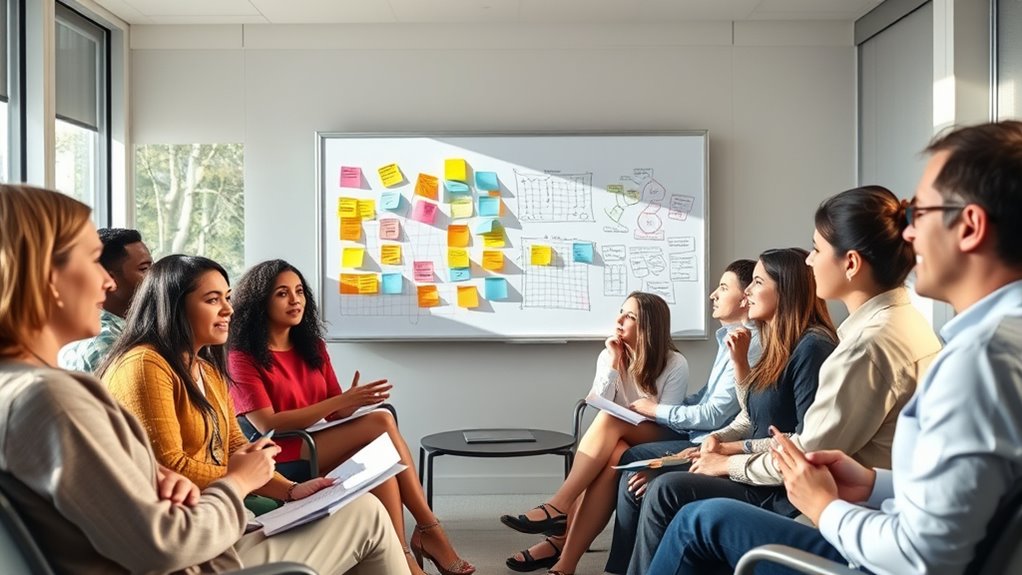
Creating an environment where team members feel safe to share honest feedback is essential for productive retrospectives. Trust building and emotional safety encourage open dialogue, helping uncover real issues. To facilitate this, focus on:
- Establishing clear ground rules that promote respect and confidentiality.
- Modeling transparency yourself, sharing your perspectives openly.
- Asking open-ended questions that invite honest responses without judgment.
These steps foster trust and make team members comfortable expressing concerns or ideas. When emotional safety is prioritized, participants are more likely to contribute sincerely, leading to richer insights. Remember, your role as facilitator is to create a supportive space where honesty is valued and protected, ensuring that the retrospective becomes a constructive, trust-filled conversation.
Tips for Engaging and Inclusive Sessions
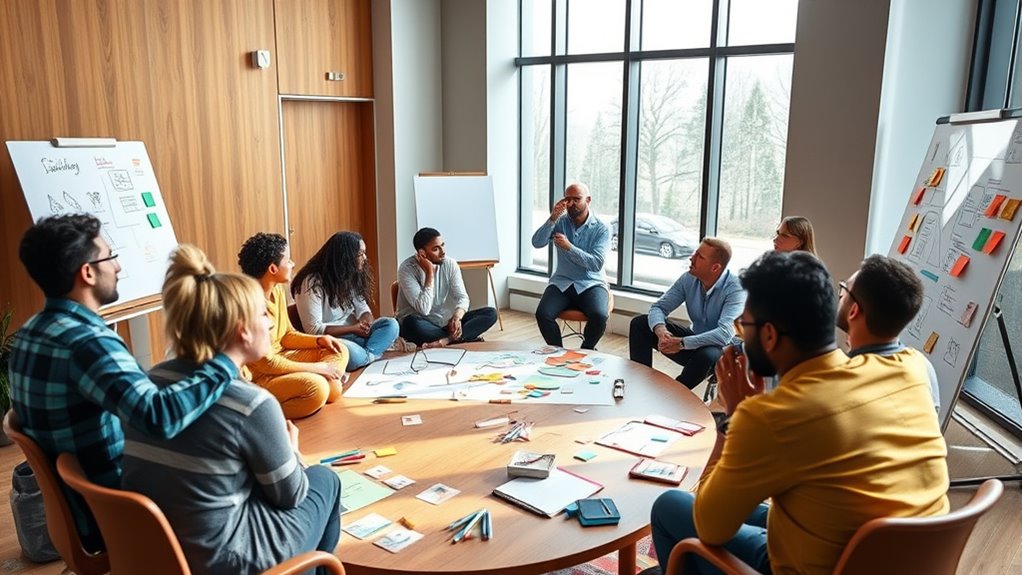
To make your retrospectives more engaging and inclusive, encourage everyone to share their unique perspectives. Incorporate interactive activities that keep participants involved and foster a collaborative environment. These approaches help guarantee all voices are heard and the session remains dynamic.
Encourage Diverse Perspectives
Encouraging diverse perspectives during retrospectives can lead to richer insights and more innovative solutions. To foster this, focus on building cultural openness and addressing unconscious bias. Here are three practical steps:
- Create a safe space where everyone feels comfortable sharing their views without judgment.
- Ask open-ended questions that invite different experiences and opinions.
- Be aware of your unconscious bias by reflecting on your assumptions and encouraging others to do the same.
Use Interactive Activities
Have you ever noticed how interactive activities can boost engagement and inclusivity during retrospectives? Incorporating such activities keeps everyone involved and encourages diverse input. Use tools like word clouds, anonymous polls, or collaborative exercises to make sessions lively and participatory. These activities break down barriers, making team members feel comfortable sharing honest feedback. By actively involving everyone, you foster team engagement and ensure different perspectives are heard. Interactive activities also add variety, preventing sessions from becoming monotonous. When you facilitate with these engaging methods, you create a space where all voices matter, leading to richer discussions and better improvement ideas. Ultimately, using interactive activities strengthens your team’s cohesion and helps transform retrospectives into productive, inclusive moments.
Handling Difficult Conversations During Retrospectives
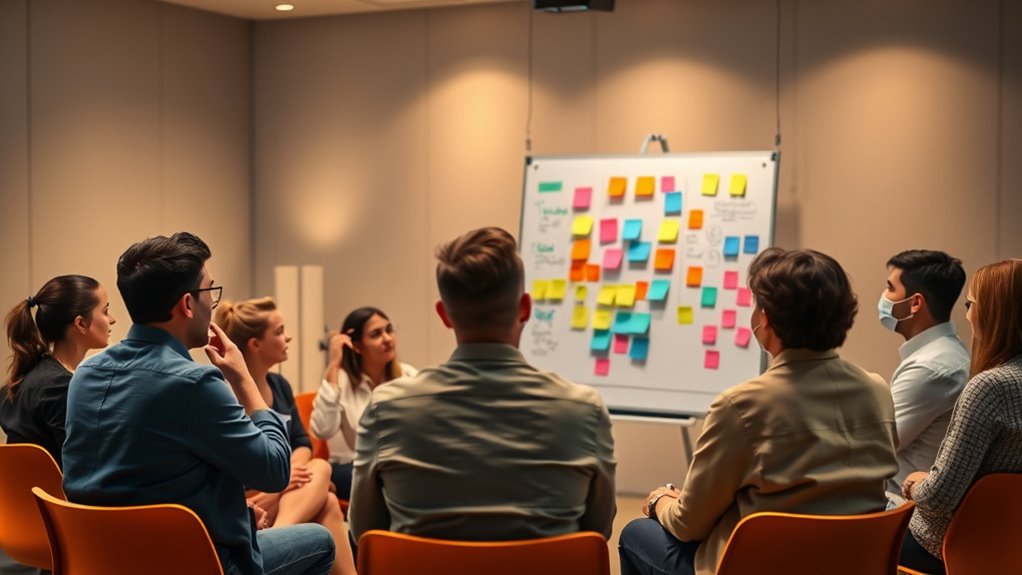
Difficult conversations often arise during retrospectives, especially when team members feel uncomfortable sharing honest feedback. To handle these situations effectively, focus on conflict resolution and emotional intelligence. First, listen actively to understand different perspectives without judgment. Second, foster a safe environment by encouraging openness and respect. Third, address emotions by acknowledging feelings and maintaining calmness, which helps de-escalate tension. By applying emotional intelligence, you can navigate sensitive topics with empathy and clarity. Remember, the goal is to turn difficult conversations into opportunities for growth, not conflict. Keeping a composed approach and promoting mutual understanding will help your team move forward productively and strengthen trust. Handling tough talks with care creates a healthier, more resilient team dynamic.
Tools and Technologies to Enhance Retrospective Sessions
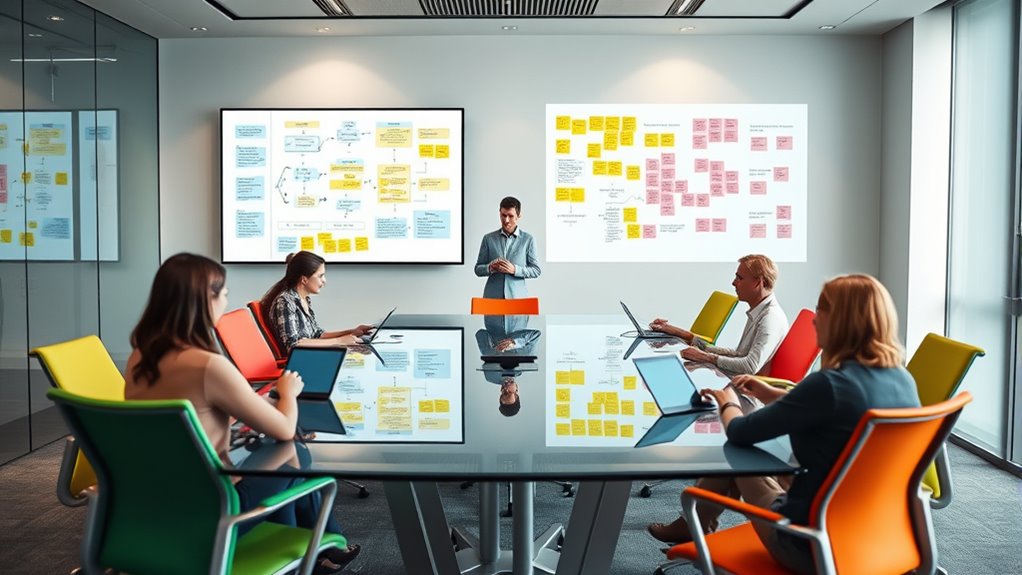
Leveraging the right tools and technologies can substantially enhance the effectiveness of your retrospective sessions. Digital tools and collaboration platforms enable seamless communication and real-time input from all team members, regardless of location. These tools help structure discussions, gather feedback, and visualize insights efficiently. For instance, digital boards like Miro or MURAL facilitate interactive activities, while platforms such as Microsoft Teams or Slack support ongoing dialogue. Using these technologies encourages participation, keeps everyone engaged, and guarantees that no voice goes unheard. They also allow you to easily review past retrospectives, track improvements, and identify recurring issues. By integrating these tools into your process, you create a more organized, inclusive, and productive environment that maximizes the value of each retrospective session.
Frequently Asked Questions
How Often Should Retrospectives Be Held for Optimal Team Growth?
You should hold retrospectives every two to four weeks to promote ideal team growth. This retrospective frequency allows your team to regularly reflect on what’s working and what needs improvement without causing fatigue. Consistent retrospectives help maintain momentum, foster open communication, and adapt processes quickly. By sticking to this schedule, you create a steady rhythm that supports continuous improvement and strengthens team collaboration over time.
What Are Common Pitfalls to Avoid During Retrospectives?
A stitch in time saves nine, so avoid common pitfalls during retrospectives. You should be aware of facilitation challenges like dominating voices, lack of focus, or blame-shifting, which can derail progress. Stay neutral, encourage open discussion, and keep the session constructive. Don’t let facilitation challenges turn into pitfalls, or you risk stifling honest feedback. Keep the environment safe and balanced for everyone to contribute meaningfully.
How Can Remote Teams Effectively Participate in Retrospectives?
To help remote teams effectively participate in retrospectives, you should focus on fostering virtual collaboration through engaging tools like video conferencing, shared documents, and interactive boards. Use engagement strategies such as rotating facilitators, breakout rooms, and polling to encourage everyone’s input. Clear agendas and time management keep the session focused, while regular check-ins make sure all voices are heard and collaboration remains strong, making the retrospective productive for everyone involved.
What’s the Ideal Team Size for Different Retrospective Formats?
You should aim for a team size of 5 to 10 members for most retrospective formats, as it encourages active participation and keeps discussions manageable. For larger teams, consider splitting into smaller groups or using shorter session durations, around 60 to 90 minutes, to maintain engagement. Smaller teams can handle longer sessions, but always prioritize creating an inclusive environment where everyone feels heard.
How Do I Measure the Success of a Retrospective Session?
Research shows that teams with clear success indicators improve by 25% more. To measure your retrospective’s success, focus on retrospective metrics like actionable outcomes and team engagement. Track changes in team collaboration, problem resolution speed, and overall satisfaction. When these success indicators improve over time, it signals your retrospectives are effective. Regularly gathering feedback and setting specific goals help you refine the process, ensuring continuous improvement.
Conclusion
Now that you know the best formats and facilitation tips, you’re practically a retrospectives superhero, ready to transform team reflections into powerful growth moments. Whether you choose timelines or fishbone diagrams, your ability to foster open, honest conversations will elevate your team’s collaboration to legendary heights. Just remember, a well-facilitated retrospective can be the secret weapon that turns ordinary projects into extraordinary successes—so go conquer those sessions with confidence!




